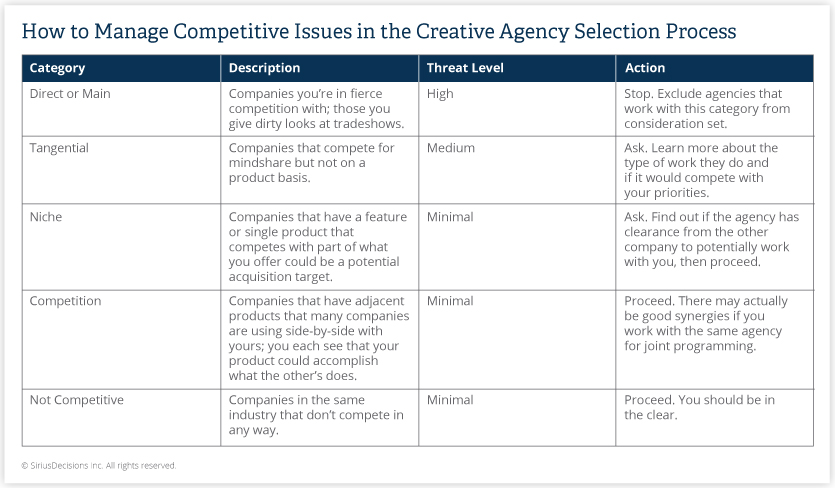How to Manage Competitive Issues in the Creative Agency Selection Process
- The problem of a creative agency having.competing clients is an evergreen issue
- Many organizations don’t want their agency to work with.competitors out of fear that classified information may be shared
- Our clients ask us for best practices for navigating this situation, but there is no one right way to go through this process
We know the feeling – you’ve fallen in love with a potential agency partner, only to learn that they have your top competitor as a client. Tears flow, you reach for the chocolate, then realize you still have to deliver this news to your boss (gulp!).
While this may be a bit dramatic, the problem of a creative agency having competing clients is an evergreen issue. You want an agency that has great domain experience to minimize onboarding time, but don’t want them working with any of your competitors for fear that classified information may be shared.
Agencies often downplay these concerns, but the reality is that companies have various levels of tolerance for this situation, and sometimes it depends on the competitor. Our clients often ask us for best practices for navigating this situation, but there is no one right way to go through this process. But before getting to the tips, make sure you have a good sense of who your competitors are. Use the following categories to create a competitor list so you know exactly what to discuss:

- Ask about competitors. In your initial conversation with an agency, ask about companies it currently services that could be considered competitors or cause problems. Ask the agency to have a discussion with these clients early on; this way, you’re not left with an agency backing out during the final stages. Often, agency contracts include clauses that give companies right of first refusal.
- Agency workarounds. Selecting an agency doesn’t have to be an all-or-nothing proposition. Many agencies offer workarounds for potential competitive issues. Some of them include having separate offices service the accounts, including separate teams even at the executive level, storing client information on separate servers without cross-team access, and a commitment to discuss your account only in meeting rooms, not in open office areas.
- Get it in writing. If you’re a bit squeamish about having to put processes in place to ensure information is shared properly, get the processes and commitment in writing. Having this information set forth in a document you can share internally goes a long way when it comes to setting everyone’s mind at ease.
- Case studies. Ask the agencies that manage similar clients how they’ve navigated this situation in the past and whether they faced any roadblocks. Request to speak with one of the competitor clients to find out how the experience has been for them.
- Regional considerations. Keep in mind that agencies with multiple offices around the globe may only be reporting on the client list within their own office. Be explicit in your conversations to find out if one of your fiercest competitors uses the same agency in a different region. Even if you only plan to use this agency in one region, you must guard against the competitor expanding work to that office. In the worst case, the agency could dump you in favor of the competitor, especially if their larger budget is larger than yours.
The agency selection process is daunting at best. However, by getting buttoned up and prepared, you’ll be in the driver’s seat. What are some of your tips or tricks you’ve gleaned from your experiences managing competitive issues during the agency selection process? Share them in the comments section below.